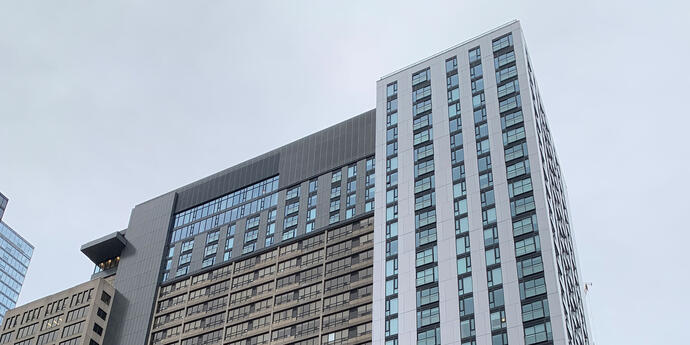
Ambitious alignment.
This project took "complexity" to new heights! A multifaceted renovation and expansion of the existing building at 99 Gerrard Street West (AKA 700 Bay Street), the project added six new floors above the existing building, including two dedicated amenity floors, a new mechanical penthouse, and structural upgrades throughout the building. This KingSett Capital development also included the addition of a 32-storey residential apartment tower adjacent to the existing office, retail, and residential space at 99 Gerrard.
Smith + Andersen was engaged as mechanical and electrical engineers for this puzzle-box project, working with the architectural and structural design teams to accommodate the project complexity, and carefully coordinating with the PCL construction team to bring the project to life.
First, we assess.
From the earliest stages of the project, Smith + Andersen performed a comprehensive mechanical and electrical modernization and upgrade assessment report for the building before the project even began. Before the project event began, we carried out a full building systems assessment on the existing building. Taking plans for the new development into consideration, we made recommendations on which capital expenditures to prioritize and identify opportunities / efficiencies to integrate the two buildings.
Next, we fit everything together.
As the project moved from an assessment to execution, the demolition of a portion of the existing building brought forth the need for careful review of existing systems and creative solutions to reroute and maintain those systems. There was a significant amount of infrastructure serving the existing building, which required reworking to make space for the new development (while keeping the existing building operational). To facilitate project phasing, we worked closely with ownership and property management to come up with solutions that involved minimizing downtime and maintaining existing tenants in place or moving them around. The full project involved complex integration between the existing building and the new development, which involved careful planning to accommodate the needs of the existing building (e.g., timing of tenant moves) and also stay within the project schedule for the new development.
Ambitious alignment.
This project took "complexity" to new heights! A multifaceted renovation and expansion of the existing building at 99 Gerrard Street West (AKA 700 Bay Street), the project added six new floors above the existing building, including two dedicated amenity floors, a new mechanical penthouse, and structural upgrades throughout the building. This KingSett Capital development also included the addition of a 32-storey residential apartment tower adjacent to the existing office, retail, and residential space at 99 Gerrard.
Smith + Andersen was engaged as mechanical and electrical engineers for this puzzle-box project, working with the architectural and structural design teams to accommodate the project complexity, and carefully coordinating with the PCL construction team to bring the project to life.
First, we assess.
From the earliest stages of the project, Smith + Andersen performed a comprehensive mechanical and electrical modernization and upgrade assessment report for the building before the project even began. Before the project event began, we carried out a full building systems assessment on the existing building. Taking plans for the new development into consideration, we made recommendations on which capital expenditures to prioritize and identify opportunities / efficiencies to integrate the two buildings.
Next, we fit everything together.
As the project moved from an assessment to execution, the demolition of a portion of the existing building brought forth the need for careful review of existing systems and creative solutions to reroute and maintain those systems. There was a significant amount of infrastructure serving the existing building, which required reworking to make space for the new development (while keeping the existing building operational). To facilitate project phasing, we worked closely with ownership and property management to come up with solutions that involved minimizing downtime and maintaining existing tenants in place or moving them around. The full project involved complex integration between the existing building and the new development, which involved careful planning to accommodate the needs of the existing building (e.g., timing of tenant moves) and also stay within the project schedule for the new development.
All in the district.
The building cooling for the new building was connected to the Enwave district chilled water plant. This allows central equipment to operate more efficiently and yields lower lifecycle costs for the equipment. On the building side, this decreases operational costs, and provides more flexibility architecturally as there is additional space real estate. The district plan also helped to avoid the use of CFC-based refrigerants, which contribute to ozone depletion. Additionally, the building hot and domestic water heating is connected to the Enwave district heating plant. The building uses low pressure steam (effectively, waste steam) as its heating source. Condensate from the building-side heat exchangers is used to pre-heat the building's domestic hot water and condenser water prior to being sent back to the district plant. Cascading form the building-side heat exchangers, is used to pre-heat the building's domestic hot water and condenser water prior to being sent back to the district plant. Cascading heating systems such as this allows the building to use as much waste heat as possible. The design also included a supplemental cooling heat exchanger to serve the existing building. It uses the chilled water return from the new building to provide additional cooling to the existing building's heat pump loop and ultimately extract as much energy as possible prior to sending water back to the district plant.
Smarter systems.
Smart thermostats were added to the residential suites, allowing for energy efficient operations of heating and cooling systems (based on occupancy). Sustainability is, quite literally, a top-down process within the building, with storm water collected from above-grade roofs reused in a car wash at the base of the building. 99 Gerrard also now includes networked lighting control for lobbies, exteriors, and the pool area.
Another significant piece of the modernization was the replacement of incoming electrical services, with an upgraded customer-owned high voltage substation within the existing basement. This required careful coordination and considered phasing in order to maintain occupancy with minimal downtime in the existing building with both office and residential occupancies. We also replaced the existing generator with a new multi-generator plant to serve the existing and new tower.








